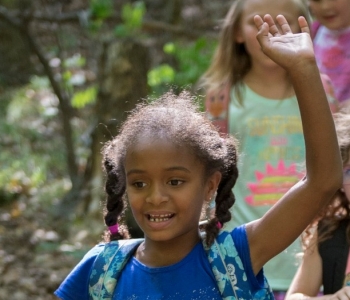The Key to Keeping It Girl-Led at Home? Teaming Up with Troop Families

Keeping girls front and center in troop matters is more important than ever. But doing so outside your usual meeting space calls for a little extra teamwork—with your troop families.
As you’ve seen firsthand, when girls take the lead, their confidence increases and they build the strength they need to power through difficult times. Parents and caregivers want what’s best for their girl, of course, and it’s hard not to want to help her through something challenging. But when girls’ new meeting spaces are now their living rooms or backyards, how can you encourage families to keep activities girl-led at home?
Our Volunteer Experts shared their advice for talking with families about what it means to be girl-led.
Explain the “whys.”
Connecting with troop families—either one-on-one or in a larger virtual meeting—can set the stage for success at home. For families that may not have volunteered at meetings before, you’ll want to explain the “whys” before offering your suggestions.
“We say that, as the girls get older and progress to higher levels in Girl Scouts, they take on more and more of the troop leadership,” says Denise Montgomery, a Cadette troop leader with Girl Scouts San Diego. “We also discuss how being girl-led is an effective strategy for maintaining girls’ interest and engagement. In other words, we make the direct link between the longevity and vitality of our troop with our troop being girl-led.”
Trina Floyd, a Cadette leader with Girl Scouts of Western Ohio, tells families that “Girl Scouts is about building leaders, and if the adults are making the decisions, the girls will not learn to make a decision and learn from that decision. If an event or trip does not go as planned, the girls look at the decisions they made and take accountability as to what went right or wrong. The girls have different ideas of what an experience should be, and as adults, we can share our knowledge but should not make the decisions.”
“One of the best quotes that I heard was by [child psychologist] Dr. Sylvia Rimm,” says Lara Cordeiro of Girl Scouts of Western Ohio. “‘The surest path to high self-esteem is to be successful at something one perceived would be difficult. Each time we steal a student's struggle, we steal the opportunity for them to build self-confidence. They must do hard things to feel good about themselves.’”
Explain the “hows.”
Being girl-led looks different at every level, of course, and you’ll want to outline what that might look like for troop families. “I would explain to a Daisy mom that a girl could choose between two petals or two outings,” says Sheila Morris, a multi-level troop leader with Girl Scouts of Green and White Mountains. “I have always explained as they get older, they can be responsible for more choices and bigger choices. I think if you keep it simple and straightforward, everyone understands.”
“While providing badge work to the girls, I have shared with families that the girls can pick the activity they do on each step,” says Julie Fuqua, a multi-level troop leader with Girl Scouts Spirit of Nebraska. “This allows them to accomplish the goals in the best way for them. This is important so that the girls continue to have interest in the activities that they are pursuing and gives them a sense of accomplishment as they continue to mature and become young leaders in our community.”
As Denise found, sometimes it's helpful to gently remind families along the way. “During our online troop parent meeting, one parent suggested that the troop have a virtual talent show,” she shares. “We said, ‘That’s a great idea, thank you. We will discuss it with the girls,’ which is a subtle reminder about the troop being girl-led. Later, during our troop meeting, there did not seem to be a lot of enthusiasm for the concept. So we will circle back and let the parent know, and we anticipate that [they] will cheerfully accept this outcome as decided by the girls.”
And, no matter girls’ ages, you can support troop families by talking about your process. “I take the time to explain how to guide instead of lead, demonstrate instead of do, and how constrained failure is part of the learning process,” says Nancy Fink, a Senior troop leader with Girl Scouts of Greater Chicago and Northwest Indiana. “We want the adults to demonstrate skills, keep the girls from hurting themselves or others, and talk about the ‘why’ behind the parts of a skill.”
Remind the adults that you’re not looking for perfection, nor are you expecting girls to breeze through activities; girls should simply do the best they can. “If it doesn't work out the way that they want, adaptability is just as important,” says Lara. “Being able to figure out how to get the job done when something is missing or doesn't work out makes much better memories than if everything is perfect. When you let the girls know that you believe they can do it, it is amazing what they get done!”





